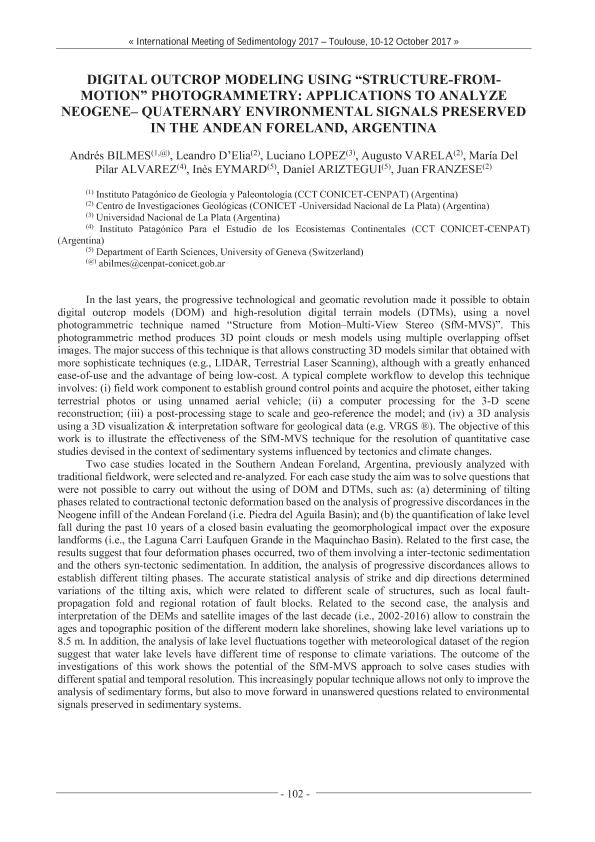Evento
Digital outcrop modeling using "Structure-from- Motion" photogrammetry: applications to analyze Neogene-Quaternary environmental signals preserved in the Andean Foreland, Argentina
Bilmes, Andrés ; D'Elia, Leandro
; D'Elia, Leandro ; López, Luciano
; López, Luciano ; Varela, Augusto Nicolás
; Varela, Augusto Nicolás ; Alvarez, Maria del Pilar
; Alvarez, Maria del Pilar ; Eymard, Inés; Ariztegui, Daniel; Franzese, Juan Rafael
; Eymard, Inés; Ariztegui, Daniel; Franzese, Juan Rafael
 ; D'Elia, Leandro
; D'Elia, Leandro ; López, Luciano
; López, Luciano ; Varela, Augusto Nicolás
; Varela, Augusto Nicolás ; Alvarez, Maria del Pilar
; Alvarez, Maria del Pilar ; Eymard, Inés; Ariztegui, Daniel; Franzese, Juan Rafael
; Eymard, Inés; Ariztegui, Daniel; Franzese, Juan Rafael
Tipo del evento:
Reunión
Nombre del evento:
33rd International Meeting of Sedimentology and 16ème Congrès Français de Sèdimentologie
Fecha del evento:
10/10/2017
Institución Organizadora:
International Association of Sedimentologists;
Título del Libro:
33rd International Meeting of Sedimentology and 16ème Congrès Français de Sèdimentologie
Editorial:
International Association of Sedimentologists
Idioma:
Inglés
Clasificación temática:
Resumen
In the last years, the progressive technological and geomatic revolution made it possible to obtaindigital outcrop models (DOM) and high-resolution digital terrain models (DTMs), using a novel photogrammetric technique named "Structure from Motion-Multi-View Stereo (SfM-MVS)". This photogrammetric method produces 3D point clouds or mesh models using multiple overlapping offset images. The major success of this technique is that allows constructing 3D models similar that obtained with more sophisticate techniques (e.g., LIDAR, Terrestrial Laser Scanning), although with a greatly enhanced ease-of-use and the advantage of being low-cost. A typical complete workflow to develop this technique involves: (i) field work component to establish ground control points and acquire the photoset, either taking terrestrial photos or using unnamed aerial vehicle; (ii) a computer processing for the 3-D scene reconstruction; (iii) a post-processing stage to scale and geo-reference the model; and (iv) a 3D analysis using a 3D visualization & interpretation software for geological data (e.g. VRGS ®). The objective of this work is to illustrate the effectiveness of the SfM-MVS technique for the resolution of quantitative case studies devised in the context of sedimentary systems influenced by tectonics and climate changes. Two case studies located in the Southern Andean Foreland, Argentina, previously analyzed withtraditional fieldwork, were selected and re-analyzed. For each case study the aim was to solve questions thatwere not possible to carry out without the using of DOM and DTMs, such as: (a) determining of tilting phases related to contractional tectonic deformation based on the analysis of progressive discordances in the Neogene infill of the Andean Foreland (i.e. Piedra del Aguila Basin); and (b) the quantification of lake levelfall during the past 10 years of a closed basin evaluating the geomorphological impact over the exposure landforms (i.e., the Laguna Carri Laufquen Grande in the Maquinchao Basin). Related to the first case, the results suggest that four deformation phases occurred, two of them involving a inter-tectonic sedimentation and the others syn-tectonic sedimentation. In addition, the analysis of progressive discordances allows to establish different tilting phases. The accurate statistical analysis of strike and dip directions determined variations of the tilting axis, which were related to different scale of structures, such as local fault propagation fold and regional rotation of fault blocks. Related to the second case, the analysis and interpretation of the DEMs and satellite images of the last decade (i.e., 2002-2016) allow to constrain the ages and topographic position of the different modern lake shorelines, showing lake level variations up to 8.5 m. In addition, the analysis of lake level fluctuations together with meteorological dataset of the regionsuggest that water lake levels have different time of response to climate variations. The outcome of the investigations of this work shows the potential of the SfM-MVS approach to solve cases studies with different spatial and temporal resolution. This increasingly popular technique allows not only to improve theanalysis of sedimentary forms, but also to move forward in unanswered questions related to environmental signals preserved in sedimentary systems.
Archivos asociados
Licencia
Identificadores
Colecciones
Eventos(CIG)
Eventos de CENTRO DE INVEST.GEOLOGICAS (I)
Eventos de CENTRO DE INVEST.GEOLOGICAS (I)
Eventos(IPGP)
Eventos de INSTITUTO PATAGONICO DE GEOLOGIA Y PALEONTOLOGIA
Eventos de INSTITUTO PATAGONICO DE GEOLOGIA Y PALEONTOLOGIA
Citación
Digital outcrop modeling using "Structure-from- Motion" photogrammetry: applications to analyze Neogene-Quaternary environmental signals preserved in the Andean Foreland, Argentina; 33rd International Meeting of Sedimentology and 16ème Congrès Français de Sèdimentologie; Toulouse; Francia; 2017; 102-102
Compartir



